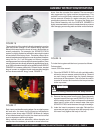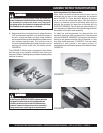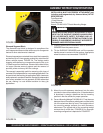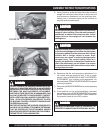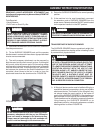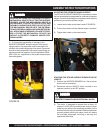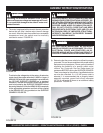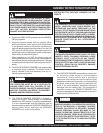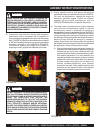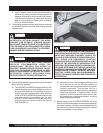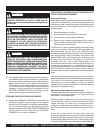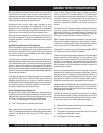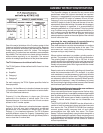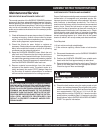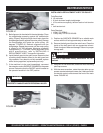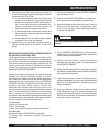
SFG10E ELECTRIC SURFACE GRINDER — OPERATION AND PARTS MANUAL — REV. #1 (07/16/07) — PAGE 26
ASSEMBLY INSTRUCTIONS/OPERATIONS
DANGERDANGER
DANGERDANGER
DANGER
WHEN OPERATING THE SURFACE GRINDER ON
ABOVE GROUND FLOOR LEVELS, EXERCISE EX-
TREME CAUTION TO PREVENT LOSS OF CONTROL
THAT COULD ALLOW THE MACHINE AND/OR OPERA-
TOR TO FALL DOWN TO LOWER LEVELS. SUCH AN
OCCURRENCE CAN RESULT IN PROPERTY DAMAGE
AND/OR PERSONAL INJURY.
2) Productivity rates with the various multi-accessory
attachments can be increased with the addition of
external weight being applied to the area over the rotating
disc. FIGURE 36. Maximum allowable external weight
is 300 lbs. Exceeding this figure can result in permanent
structural damage to the SURFACE GRINDER.
Provisions for securing the weight by the means of
strapping or other, appropriate methods is provided.
FIGURE 36
DANGERDANGER
DANGERDANGER
DANGER
DO NOT OPERATE THE SURFACE GRINDER WITH-
OUT ALL EXTERNAL WEIGHT PROPERLY SECURED
TO THE MAIN FRAME. A SUDDEN CHANGE IN MOVE-
MENT OR DIRECTION CAN ALLOW THE
UNSECURED WEIGHT TO FALL OFF THE SURFACE
GRINDER, RESULTING IN LOSS OF MACHINE CON-
TROL, PROPERTY DAMAGE AND/OR PERSONAL
INJURY. THIS PROCEDURE IS ESPECIALLY IMPOR-
TANT WHEN OPERATING THE SURFACE GRINDER
ON FLOORS AND/OR SURFACES ABOVE GROUND
LEVEL.
3) Proper operator posture and stance will enhance
operational safety and overall productivity. FIGURE 38.
For most job applications, operate the engine at
maximum, governed speed. Consult the material
supplied by the engine manufacturer and the
SPECIFICATIONS section for specific information.
4) The wide variety of potential work surface materials
along with the corresponding variety of job site
environments, makes it impossible to develop a
standardized operating procedure for the SURFACE
GRINDER. Use of the SURFACE GRINDER will require
constant trial and error testing until satisfactory results
are achieved. Experience gained over time and common
sense will help minimize the amount of necessary
testing. Many factors will directly affect the operating
parameters and/or techniques utilized for a specialized
job application. Some of these factors include:
a) Work surface material yield and tensile values. As
a general rule, these values will determine material
removal rate per unit of time. Materials with high
yield and tensile values will characteristically resist/
limit material penetration. For such materials, the
accepted procedure is to make a number of multiple
passes over the work surface rather than attempt
to make a single, deep pass. The net effect is to
actually increase productivity: more material
removed in less time. Other added benefits to this
technique are decreased vibration, less operator
fatigue and increased component service life.
FIGURE 38



